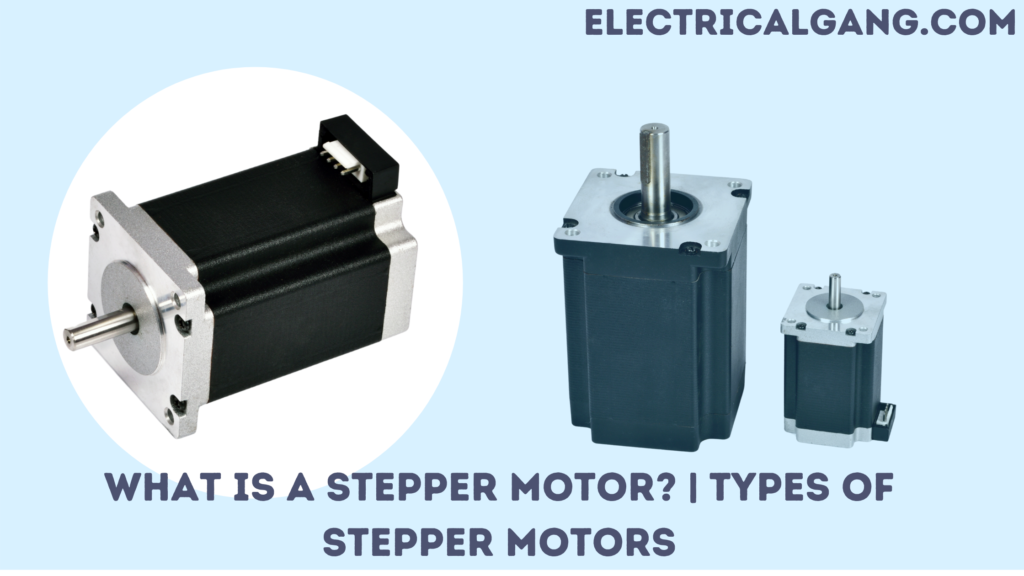
Hello friends, in today’s article, we will see what a stepper motor is, what are the Types of Stepper Motors and what are their advantages and disadvantages. We will discuss this in detail in today’s article.
What is a Stepper Motor?
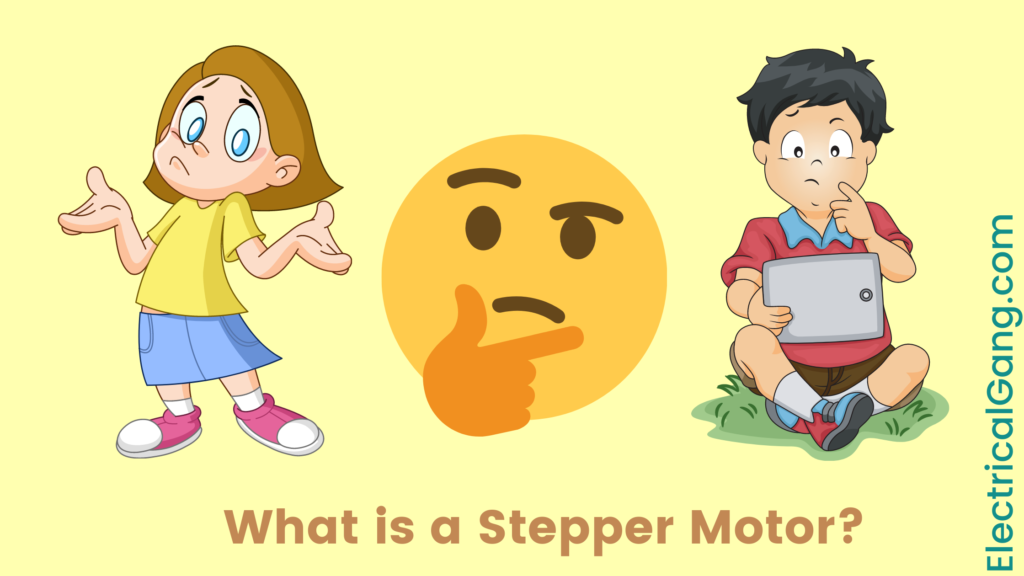
A stepper motor is an electromechanical device that converts electrical energy into mechanical energy. Also, a brushless, synchronous electric motor can rotate the entire rotation in a large number of steps. The position of the motor can be precisely controlled without any reaction mechanism as long as the motor is careful in the size of the application.
Stepper motors are similar to switched reverse motors. This motor uses the principle of operation for a magnet. The time when the pulse of electricity is supplied will make the motor shaft a certain distance. The stepper motor stator has eight poles, while the rotor has six poles.
To make a complete revolution, the rotor would need 24 pulses of electricity to move 24 steps. To put it another way, for each pulse of electricity received by the motor, the rotor will move exactly 15 °.
Also Read: What is Electric Motor? | Different Types of Electric Motors
Construction of Stepper Motor:
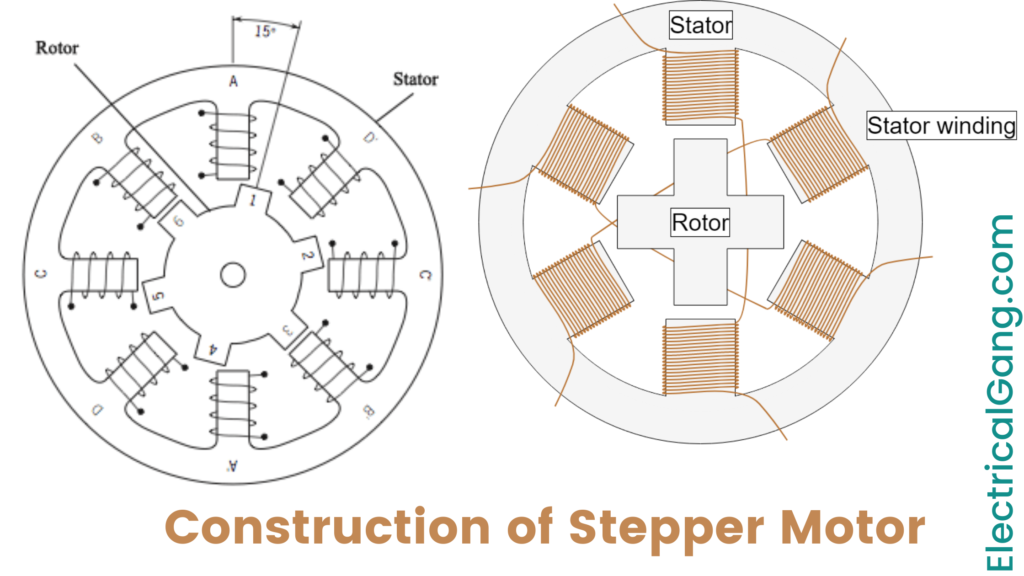
The construction of the stepper motor is similar to that of a DC motor. It consists of a permanent magnet like a rotor which is located in the center and will rotate after its forced action. This rotor is bound by a no stator which is wound by a whole magnetic coil. The stator is arranged close to the rotor so that the magnetic fields inside the stator can control the speed of the rotor.
This motor can be controlled by giving each stator one power after another. So the stator will become a magnet and act as an electromagnet pole, which uses the resistive energy on the rotor to move forward. The second magnetizing, as well as demagnetizing of the stator, will slowly shift the rotor and allow it to rotate under greater control.
Working Principle of Stepper Motor:
The working principle of a stepper motor is electro-magnetism. It has a rotor made with a permanent magnet. At the same time, the stator is with the electromagnet. Once this is supplied with a power supply, a magnetic field is created inside the stator. Now the rotor in the motor continues to move along the rotating magnetic field of the stator. So this is the basic working principle of this motor.
This motor has a soft iron surrounded by electromagnetic. Not based on the type of stator pole as well as the rotor stepper. The stator of this motor is excited once the power is given. The rotor will then rotate to align itself with the stator. Otherwise, the minimum distance traveled by the stator. This way, the stepper motor is activated in series to rotate.
Driving Techniques:
Due to the intricate design of this motor, the driving techniques of the stepper motor with some special circuits become possible. There are many methods in the market to operate this motor. Four of them are discussed below with an example.
Single Excitation Mode:
The basic method of operating a stepper motor is a single excitation mode. This is an old system that is not used in the current standard. Also, need to know about this technique. In this system, the stator will be alternately triggered alternately in each phase or with a special circuit. This will magnetize and demagnetize the stator to move the rotor forward.
Full Step Drive:
In this system, two stators become active in a short period of time. This technic results in higher torque and allows the motor to run with more load.
Half-Step Drive:
This system is closely related to a full-step drive. Because the two stators will be arranged side by side so that it will be activated first, then the third will be activated after that. This type of cycle is for replacing the first two stators, and then the third stator will run in the motor. This will result in improved resolution of the stepper motor while reducing the resulting torque from the treadmill.
Micro Stepping:
Micro-stepping systems are used mostly due to inaccuracies. The variable step current will supply the stepper motor drive circuit to the stator coil as a sinusoidal waveform. The accuracy of each step can be increased by this small step current. This system is widely used. This is because it provides more accuracy and, at the same time, reduces the amount of operating noise.
Also Read: What Is an Induction Motor | Types of Induction Motor
Types of Stepper Motors:
There are three main types of stepper motors which are as follows:
| Sr.No | Types of Stepper Motors |
| #1. | Permanent Magnet Stepper |
| #2. | Hybrid Synchronous Stepper |
| #3. | Variable Reluctance Stepper |
#1. Permanent Magnet Stepper:
This type of motor uses a permanent magnet in the rotor. The rotor acts on the attraction or repulsion between the Permanent Magnet and the stator electromagnet.
This motor is the most common type of motor compared to the different types of stepper motors available in the market. In this motor, a permanent magnet is involved in the construction of the motor. This type of motor is also known as a tin-can/can-stack motor. The main advantage of this stepper motor is that its production cost is low. Each revolution has 48-24 steps.
#2. Hybrid Synchronous Stepper:
That is why this motor is named. This is because they use a combination of permanent magnets and variable reluctance technic to achieve maximum power in small package sizes.
This is one of the most popular types of motor. This is because the motor gives the best performance compared to a permanent magnet rotor in terms of speed, step resolution, and holding torque. But this motor is expensive compared to Permanent Magnet Stepper Motor.
This motor combines the features of both a permanent magnet and a variable reluctant stepper motor. Such motors are used in places where low stepping angles such as 1.5, 1.8, and 2.5 degrees are required.
#3. Variable Reluctance Stepper Motor:
This type of motor has a rotor of plain iron in the variable reluctance motor, and it operates on the principle that the minimum reluctance occurs with the minimum distance, so the rotor points are attracted to the stator magnet poles.
Stepper motors like variable reluctance are the basic type of motor and have been used for many years. As its name suggests, the angular position of the rotor depends primarily on the reluctance of the magnetic circuit, which can form the teeth of the stator as well as the rotor.
How to Select a Stepper Motor?
Before choosing a stepper motor according to your needs, it is necessary to check the torque and speed curve of the motor. All this information is available to its manufacturer and is a graphical representation of the torque of a motor at a certain speed.
The torque and speed curve of the motor should match or closely match the requirement of the application. Otherwise, the expected system performance cannot be achieved.
Types of Wiring:
A stepper motor is usually a two-phase motor such as unipolar or otherwise bipolar. In a unipolar motor, there are two windings for each phase. Here, the center-taped is a common lead between the two windings towards the pole. Unipolar motors have 5 to 8 leads.
In construction, where the two poles are usually divided, the center-taped stepper motor contains six leads. If the two poles are short inside the center tap, then this motor contains five leads.
Unipolar with eight leads will facilitate both these connections, such as series and parallel. While a motor with five leads or six leads has a series connection of stator coils. Unipolar motors can be operated easily as they do not need to reverse the flow of current inside the driving circuit when they are running, which is known as bifilar motors.
The bipolar stepper motor has the same winding for each pole. The direction of supply needs to be changed by the driving circuit so that it will complicate the process. This is why such a motor is also known as the unifilar motor.
Stepper Motor Circuit & Its Operation:

The function of the stepper motor is different from that of the DC motor. It rotates when a power supply is supplied to its terminal. While in the stepper motor, on the other hand, the electromagnet of the tooth is effectively arranged around the central gear-shaped part of the iron. The electromagnet is excited by an external circuit. For example, a microcontroller.
The first electromagnet is powered to rotate the motor shaft. Which magnetically attracts the teeth of the gear to the teeth of the electromagnet. The time when the teeth of the gear are first aligned with the electromagnet. It is then slightly offset by the forward electromagnet.
That’s why when the front electromagnet is turned on, the first one is off. The gear then rotates slightly to align with the front. And from there, the process is repeated. Each of these rotations is called a step. In which the integer does a complete rotation.
This way, the motor can be rotated in a certain way. The stepper motor does not rotate continuously like other motors. They turn into steps. The stator has four coils with a 90o angle between them.
The stepper motor is determined by the way the connection coils are connected to each other. In the stepper motor, the coil is not connected. The motor has a 90o rotation step in which the coils are excited in a cyclical sequence, which determines the direction of shaft rotation.
The operation of this motor is shown by the operation of the switch. The coil becomes active in series with an interval of 1 second. The shaft rotates 90o each time the next coil is activated. Its low-speed torque will change with direct current.
Also Read: What Is Stator? | Construction of Stator
Difference Between Stepper Motor and Servo Motor:

The servo motor is suitable for high torque and speed applications. While stepper motors are less expensive so, use this where high holding torque, acceleration with low-to-medium, the open otherwise closed-loop operation requires flexibility.
The main differences between Stepper Motor and Servo Motor are as follows:
| Stepper Motor | Servo Motor |
| A motor that moves in independent steps is known as a stepper motor | A Servo motor is a type of closed-loop motor. Which is connected to an encoder to provide motion feedback and position |
| The stepper motor is used in a place where control, and precision, are the main priority | Servo motors are used where speed is the main priority |
| The overall pole count of a stepper motor ranges from 50 to 100 | The overall pole count of the servo motor ranges from 4 to 12 |
| In a closed-loop system, this motor moves with a continuous pulse | These motors need an encoder to replace the pulses to control the condition. |
| Torque increases at low speeds | Torque is low at high speeds |
| Positioning time in short strokes is fast | Positioning time is faster during long strokes |
| Moment of high tolerance of inertia | Moment of low tolerance of inertia |
| The response is overwhelming | Responsibility is low |
| This is used to increase fluctuations | This is not used to increase fluctuations |
| Adjustment of gain/tuning is not necessary | Adjustment of gain/tuning is required |
Stepper Motor vs. DC Motor:
Stepper motor and DC motor Both these motors are used in various industrial applications. But the difference between the two motors is a bit confusing. Here we are listing some common characteristics between these two motors. Each feature is discussed below.
| Characteristics | Stepper Motor | DC Motor |
| Control Characteristics | Simple and uses a microcontroller | Easy and no additions required |
| Speed Range | Low from 200 to 2000 RPM | Medium |
| Reliability | High | Moderate |
| Efficiency | Low | High |
| Torque or Speed Characteristics | Highest torque at low speeds | High torque at low speeds |
| Cost | Low | Low |
Parameters of Stepper Motor:
Stepper motor parameters mainly include step angle measures for each revolution and steps per second, and rpm.
Step Angle:
The step angle of a stepper motor can be defined as the angle at which the motor rotor rotates once. Once input is given to the stator. The resolution of the motor can be defined as the number of steps of the motor and the number of revolutions of the rotor.
Resolution = Number of Steps/Number of Revolution of the Rotor
The alignment of the motor can be determined by the step angle and can be expressed in degrees. The resolution of the motor is the number of steps made within a revolution of the rotor. When the step angle of the motor is small, the resolution for the configuration of this motor is higher.
The accuracy of the object’s alignment by this motor depends mainly on the resolution. Once the resolution is high, then the accuracy will be low.
Some precision motors can make 1000 steps within a single revolution, including 0.36 degrees of step angle. A typical motor includes a 1.8-degree step angle with 200 steps for each revolution.
Different angles such as 15 degrees, 45 degrees, and 90 degrees are very common in a normal motor. The number of angles can vary from two to six, and a small step angle can be achieved by slotted pole parts.
Also Read: What Is a Motor Starter? | Types of Motor Starters
Steps for Each Revolution:
The steps of no for each resolution can be defined as the number of angles of action required for the total revolution. The formula for this is 360 ° / step angle.
Steps for Each Second:
This type of parameter is mainly used to measure the number of steps covered per second.
Revolution Per Minute:
RPM is a revolution every minute. This is used to measure the frequency of revolutions. So using this parameter, we can calculate the number of revolutions in a single minute.
The main relationship between the dimensions of the stepper motor is as follows:
Steps for Each Second = Revolution per Minute x Steps per Revolution/60
Can Stepper Motors Run Continuously?
Normally all motors run or rotate continuously. But most motors cannot be stopped when they are under power. When you try to block the shaft of the motor when it is under the power supply, it will burn or break.
Alternatively, the stepper motor is designed to make a special step. Then wait there; Step up again and stay there. If we stop the motor in one place for a short time before we take action again, it will appear to be running continuously.
The power consumption of this motor is high, but power dissipation mainly occurs once the motor is turned off. Or overheating is likely to occur after being poorly designed. For this reason, the current supply of the motor is often reduced once the motor is in the holding position for a long time.
The main reason is that after turning the motor, its input electrical power part can be converted into mechanical power. It is stopped when the motor is rotating. All input power inside the coil can then be converted to heat.
Also Read: What Is Motor Winding | Types of Motor Winding | Motor Winding Calculation
Advantages of Stepper Motor:
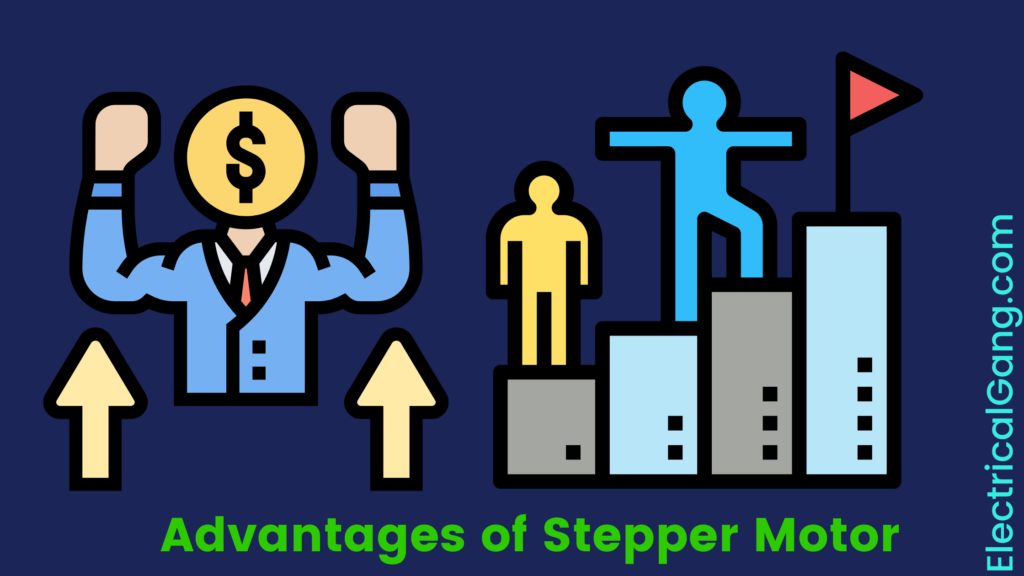
Some of the advantages of the stepper motor are as follows:
- Easy construction.
- Hardness.
- Requires less maintenance.
- Can work in any situation.
- Reliability is high.
- The standalone motor has full torque.
- Can work in the open-loop control system.
- Very reliable because there is no contact brush in the motor.
- The life of a motor depends only on the life of its bearing.
- Excellent feedback for starting, closing, and vice versa.
- The rotation angle of the motor is proportional to the input pulse.
- A wide range of rotational speeds can be experienced as the frequency speed of the input pulses is proportional.
Disadvantages of Stepper Motor:
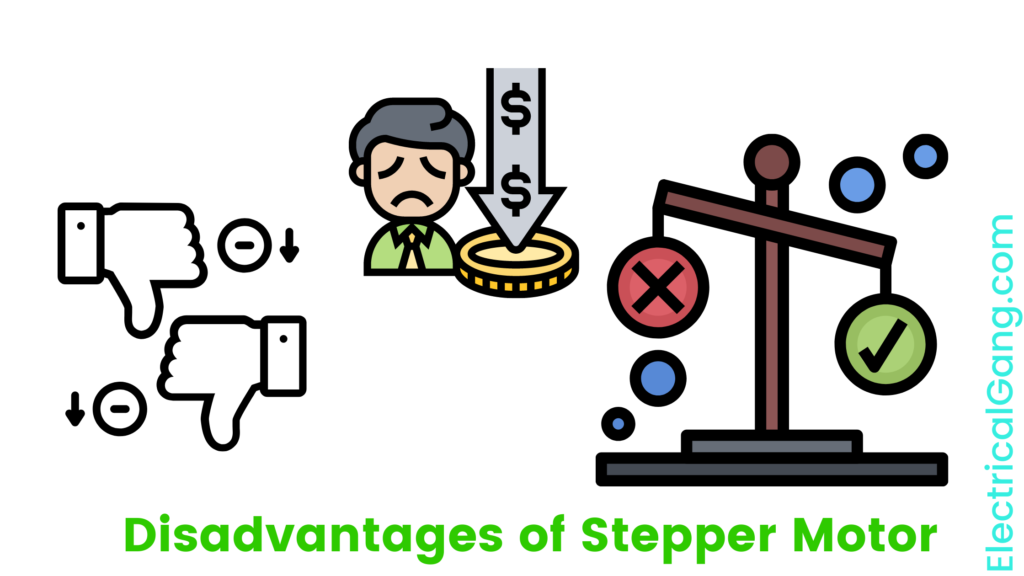
As the advantages of a stepper motor, there are also some disadvantages which are as follows:
- Efficiency is low
- Accuracy is low.
- The torque of the motor will decrease rapidly with speed.
- Small torque towards inertia ratio.
- Heavy noise.
- Operating this motor at very high speeds is not easy.
- A dedicated control circuit is required.
- Compared to DC motors, it uses more current.
- Resonance can occur if the motor is not controlled properly.
Applications of Stepper Motor:
Some of the applications of the stepper motor are as follows:
- Industrial Machine: Stepper motors are used in automotive gauge and machine tooling automatic production devices.
- Security: New surveillance products for the security industry.
- Consumer Electronics: Stepper motors in the camera for automatic digital camera focus and zoom function.
- Medical: Stepper motors are used inside medical scanners, and samplers, and are also found inside digital dental photography, fluid pumps, respirators, and blood analysis machinery.
Most Commonly Asked Questions:

How Many Stepper Motor Types are in the Market?
| Sr.No | Types of Stepper Motors |
| #1. | Permanent Magnet Stepper |
| #2. | Hybrid Synchronous Stepper |
| #3. | Variable Reluctance Stepper |
Stepper Motor Construction or Construction of a Stepper Motor.
The construction of a stepper motor is closely related to that of a DC motor. It consists of a permanent magnet-like rotor. Which is located in the middle, and once a force acts on it, it will turn. This rotor is bound by a no. of the stator, which is wound on it by a magnetic coil.
Like this post? Share it with your friends!
Suggested Read –